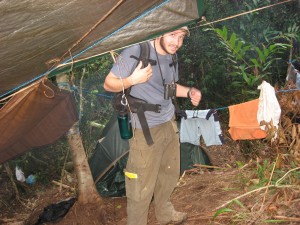Braden Godwin
Braden Godwin
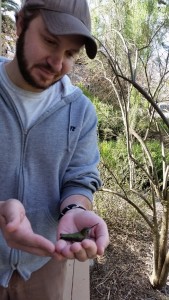 Braden Godwin
Braden Godwin
Position: 2015-2019 Graduate student, graduated December 2019
Project: Hummingbird population genomics and disease ecology
Education: B.Sc, Conservation Biology, Marlboro College, 2008; M.Sc, Zoology and Physiology, University of Wyoming, 2014; M.Sc, Veterinary Sciences and Environmental and Natural Resources University of Wyoming, December 2020. (Brady next became a Biology Instructor at Sheridan College/Gillette campus)
Email: bgodwin@uwyo.edu
Research interests
The heart of my interests lie in the ecology, conservation, and management of wildlife. Today we have available a wide range of molecular tools and techniques using cutting edge technology, such as next generation sequencing, that can help us answer a wide range of questions that were previously very difficult or impossible. I use these, coupled with more traditional ecological techniques, to research species of interest and contribute to our knowledge of ecology in an increasingly changing environment.
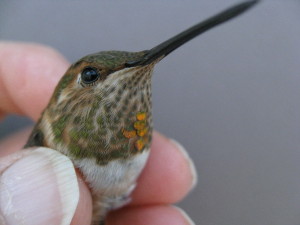 Hummingbird genomics and disease ecology (University of Wyoming)
Hummingbird genomics and disease ecology (University of Wyoming)
Hummingbirds are beautiful, charismatic birds that are popular with the general public. However, very little is known about much of their basic ecology, population structure, and potential stresses from the changing environment and landscape, especially in North America. I use genomic techniques to investigate the population structures and genetic diversity of hummingbird species in the Western United States and couple those findings with landscape ecology, avian disease and parasite prevalence, and climate change in order to better understand the current status of these species.
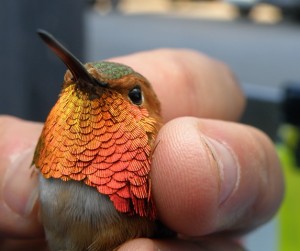 Sentinel species
Sentinel species
Sentinel species are a specific type of indicator species, used to give indications of environmental threats and hazards that could pose risks to humans. They are, essentially, “canaries in the coal mine.” Specific and targeted monitoring for many of these hazards, such as air and water pollution, can be highly effective. However, if the specific hazard is unknown or the environment is exposed in pulsed events that could be missed by humans, sentinel species are ideal to monitor as they will accumulate any and all hazards in the environment and we can study their populations, distributions, and physiology to find warning signs. This sort of work is often cheaper than extensive chemical testing in laboratories, and can give strong initial support for beginning that sort of targeted monitoring.
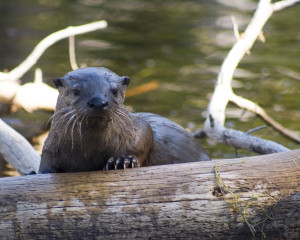 River otters in Wyoming (University of Wyoming)
River otters in Wyoming (University of Wyoming)
North American river otters are a sentinel species for water pollution and have been used to indicate poor water quality in instances such as runoff from mines and the Exxon Valdez Oil Spill. I used non-invasive genetic methods to estimate river otter population densities and distribution in the Green River Basin in Southwestern Wyoming. There is growing concern over increased energy extraction in the region and its effects on air and water quality. I found that otters strongly avoid stretches of river closest to, and immediately downstream of, the most intensive energy extraction. This distribution could not be explained by natural factors such as riparian habitat and prey. I found that the increased human activity may be deterring otters from certain areas, and in those areas there was also unusually high water conductivity, potentially indicating contaminants in the river. It is my hope that this study will provide support for intensive surface water monitoring in the region.
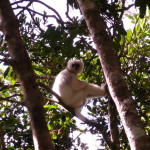
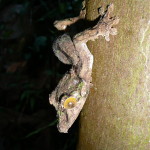 Island biodiversity and conservation (Marlboro College)
Island biodiversity and conservation (Marlboro College)
During my undergraduate education I obtained an internship in Madagascar working for Dr. Erik Patel surveying lemurs in a remote part of the northeastern rain forests. The number and diversity of endemic species of all taxa on the island is incredible, and they are almost all threatened by a very high rate of habitat loss across the entire island. This experience cemented my interest in ecology and conservation, especially in threatened biodiversity hotspots, and has shaped my career and research since. I encourage anyone that is able to (responsibly) visit, work in, or donate to help the people and wildlife of Madagascar, to take the opportunity to appreciate and support that unique island.
Publications
B.L. Godwin, S.E. Albeke, H.L. Bergman, A. Walters, and M. Ben-David. (2015) Density of river otters (Lontra canadensis) in relation to energy development in the Green River Basin, Wyoming. Science of the Total Environment, 532: 780-790.
Presentations
“River otters and fracking in Wyoming,” April 2015 – Communicating Science Workshop (open to public), Laramie, WY
“Non-invasive Genetic Techniques for Monitoring River Otters in Wyoming,” May 2014 –Wyoming Game and Fish Department, Lander, WY
“Otters, Feces, and Fracking,” February 2014 –University Chapter of the Wildlife Society, University of Wyoming, Laramie, WY
“Long-term monitoring protocol for river otters in Southwest Wyoming,” November 2012 – Wyoming State Wildlife Society Conference, Laramie, WY
“Developing protocols for long-term monitoring of river otters in Southwest Wyoming,” September 2012 – The Wildlife Society CMP Regional Annual Conference, Bismarck, ND
“River otters in the Green River Basin,” March 2012- Zoology and Physiology Departmental Seminar, University of Wyoming, Laramie, WY
“Does Natural Gas Mining Affect River Otters in the Green River Basin?” November 2011 –Regional Wildlife Society, Jackson Hole, WY
In the news:
 Featured in the Buffalo Bulletin:
Featured in the Buffalo Bulletin:
Hummingbird Health
by Jen Sieve-Hicks
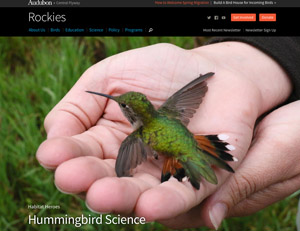 Featured in Rockies Audubon:
Featured in Rockies Audubon:
Lab member is “Habitat Hero”: Brady Godwin guest blogs for Rockies Audubon about hummingbirds, looks for feeders to band at
by Brady Godwin
 Featured in the Laramie Boomerang:
Featured in the Laramie Boomerang:
Read about PhD student Brady Godwin studying hummingbird health
by Eve Newman
[whohit]Brady Godwin[/whohit]

